Physical Science Chapter 5 Review Wave Motion and Sound
ncert cbse notes for class nine science physics chapter 12 sound, audio 9 notes, class 9 science notes, sound class 9, sound grade 9 notes, class nine sound, note science, scientific discipline notes, audio, class nine cscience chapter 12 notes, 9th standard science notes, ninth std science notes, class ix science notes affiliate 12, sound chapter course 9 notes
NCERT CBSE Notes for Course 9 Science physics
Chapter 12 SOUND
1. Product of Sound
Sound is produced due to the vibration of objects. Vibration is the rapid to and fro motion of an object.
Vibrating objects are the source of all sounds Irregular, chaotic vibrations produce noise Regular, controlled vibration can produce music All sound is a combination of pure frequencies
A stretched prophylactic band when plucked vibrates and produces sound.
2. Propagation of Sound
When an object vibrates, the particles effectually the medium vibrate. The particle in contact with the vibrating object is first displaced from its equilibrium position
The disturbance produced past the vibrating trunk travels through the medium but the particles do not motility forward themselves.
A wave is a disturbance which moves through a medium by the vibration of the particles of the medium. And then audio is considered as a wave.Sound waves Require medium for transmission.Sound waves are called mechanical waves. When a vibrating object moves forward, information technology pushes and compresses the air in front of it forming a region of loftier force per unit area called pinch (C). When the vibrating object moves backward, it forms a region of low pressure level called rarefaction (R).

A vibrating object producing a series of compressions (C) and rarefaction (R)
In these waves the particles movement dorsum and along parallel to the management of propagation of the disturbance. Such waves are called longitudinal waves.
In that location is some other kind of waves called transverse waves. In these waves the particles oscillate up and down perpendicular to the propagation of the direction of disturbance.
Sound propagates in a medium as a series of compressions (C) and rarefactions (R).
Compressions are the regions of high pressure and density where the particles are crowded and are represented by the upper portion of the bend called crest.
Rarefactions are the regions of low pressure and density where the particles are spread out and are represented by the lower portion of the curve chosen trough
Characteristics of a audio moving ridge
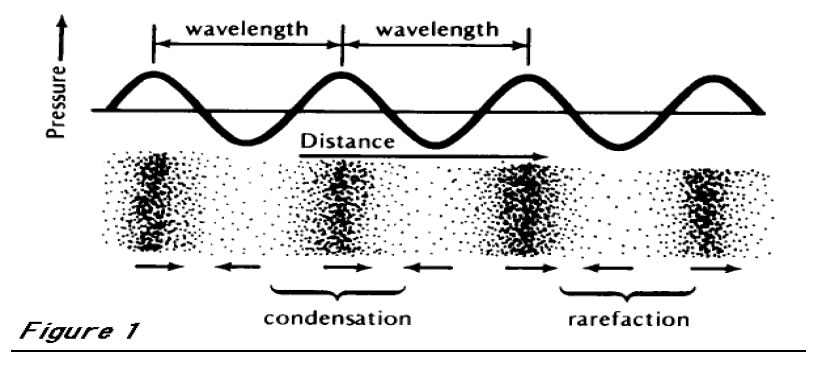
Frequency of audio moving ridge
The number of oscillations per unit time is called the frequency of the audio wave.
Information technology is represented by the symbol ٧ (Greek letter nu). Its SI unit of measurement is hertz (Hz)
Time flow of audio wave
Frequency and time are represented equally follows:-
٧ for one oscillation
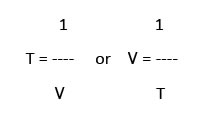
Amplitude of audio wave
The amplitude of sound moving ridge is the top of the crest or tough.
It is represented by the letter A. The SI unit is the same as that of density or pressure.Wavelength
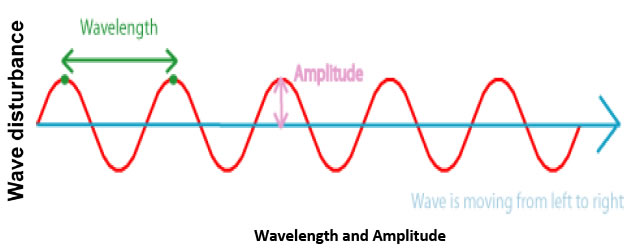
The wavelength is the distance between the "crests" of 2 waves that are next to each other. The amplitude is how high the crests are
Pitch and loudness of sound
The pitch of sound (shrillness or flatness) depends on the frequency of vibration.
If the frequency is high, the sound has high pitch and if the frequency is low, the sound has low pitch
Speed of sound
The speed of audio is more in solids, less in liquids and least in gases.
The speed of sound also depends on the temperature of the medium. If the temperature of the medium is more, the speed of sound is more
3. Reflection of Sound
Audio gets reflected at the surface of a solid or liquid and follows the laws of reflection.
i) The angle of incidence is equal to the angle of reflection.
ii) The incident ray, the reflected ray and normal at the point of incidence all lie in the aforementioned plane
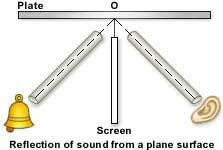
4. Echo
If nosotros shout or handclapping near a reflecting surface like tall building or a mountain, nosotros hear the same sound over again. This sound which nosotros hear is called echo. It is caused due to the reflection of sound.
To hear an repeat clearly, the fourth dimension interval betwixt the original sound and the echo must be at to the lowest degree 0.i s.
Since the speed of sound in air is 344 1000/due south, the distance travelled by sound in 0.I s = 344 g/s x 0.1 due south = 34.iv m
And so to hear an echo conspicuously, the minimum distance of the reflecting surface should be half this distance that is 17.2 m.
Reverberation
Echoes may be heard more than once due to repeated or multiple reflections of sound from several reflecting surfaces. This causes persistence of audio called reverberation. In big halls or auditoriums to reduce reverberation, the roofs and walls are covered by sound absorbing materials similar compressed fibre boards, crude plaster or draperies.
5. Uses Of Multiple Reflection Of Sound
Megaphones, horns, musical instruments like trumpets, etc. are deigned to ship audio by multiple reflection in a particular direction without spreading in all directions.
two) Doctors mind to sounds from the human body through a stethoscope. The audio of heartbeat reaches the dr.'due south ears by multiple reflection.
iii) Mostly the ceilings of cinema halls and auditoriums are curved so that sound after multiple reflection reaches all parts of the hall. Sometimes a curved sound board is placed backside the stage so that sound after multiple reflection spreads evenly across the hall.
6. Range of Hearing
Human beings can hear sound frequencies betwixt 20 Hz and 2000 Hz
Sound whose frequency is less than xx Hz is called infrasonic sound
Sound whose frequency is more than 2000 Hz is called ultrasonic sound
7. Uses of ultrasonic sound
Ultrasonic audio is used to make clean objects similar electronic Components, used to detect cracks in metal blocks, used in ultra audio scanners for getting images of internal organs of the human torso used to break small stones formed in the kidneys into fine grains.
8 Sonar
Information technology is a device which uses ultrasonic waves to measure distance, direction and speed of underwater objects. The distance of the object tin be calculated past knowing the speed of sound in h2o and the time taken between the transmission and reception of ultrasound
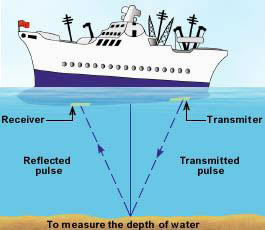
9.Construction of the human ear
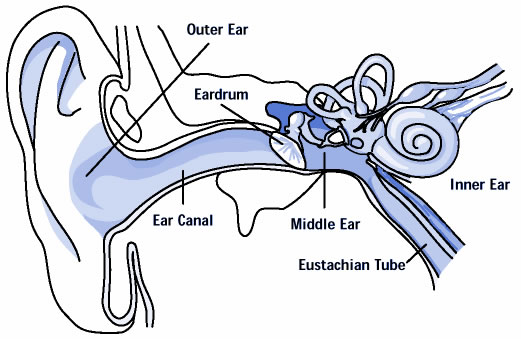
The sound waves passes through the ear canal to a thin membrane called eardrum. The eardrum vibrates. The vibrations are amplified by the iii bones of the middle ear called 130 hammer, anvil and stirrup. Middle ear and so transmits the sound waves to the inner ear. The brain then interprets the signals equally sound.
QUESTION BANK
I mark questions
i. What do you understand past sound waves?
2. Requite an example to bear witness that audio travels at a finite speed.
three. Is sound wave longitudinal or transfer.
four. Proper noun ii quantities that vary periodically at a place in air as a sound wave travels through it .
5. An aeroplane produces a sound wave with frequency of 5 KHz and wavelength 30 m. In how much time would the audio wave comprehend the distance of 4 Km?
6. With the help of a diagram show how longitudinal waves similar sound waves travel in air.
7. With the help of a diagram bear witness how longitudinal waves like sound waves travel in air.
8. Can nosotros hear the ringing of a mobile phone placed in a vacuum chamber?
9. Can 2 astronauts talk on moon a they does on the surface of the world?
2 marks questions
1. Explicate how echoes are used by bats to guess the distance of an obstacle?
2. Country the special backdrop of ultrasound that make it useful to us .In general, how these properties are utilized.
3. Why is soft furnishing avoided in concert halls?
four. Describe a diagram depicting low pitched sound and high pitched sound and write main deviation between the two?
5. Distinguish betwixt longitudinal and transverse waves.
half dozen. An explosion takes place at the moon. After what fourth dimension would it exist heard at the earth?
Give one example each.
Iii marks questions
ane. Two sources A and B vibrate with the aforementioned amplitude. They produce sounds of frequencies 1 kHz and 30 kHz respectively. Which of the two waves volition accept greater power?
ii. Notice the fourth dimension period of the source of a audio wave whose frequency is 400Hz.
three. A sound moving ridge travels at a speed of 340m/s. If its wavelength is two cm, what is the frequency of the wave? Will it be in the audible range?
4. The grandparents and parents of a two year daughter are playing with her in a room. A sound source produces a 28—kHzsound.who in the room is most likely to hear the sound?
Five marks questions
1. Sound cannot travel in vacuum. Describe an experiment to demonstrate this.
2. With the help of a diagram draw how pinch and rarefaction pulses are produced in air near a source of audio. 3. Explain briefly how a flaw in a mental component can be detected using ultrasound?
4. Explain the working and application of SONAR.
5. A monkey drops a coconut from the top of a tree. He hears the sound of the kokosnoot hitting the basis 2.057 seconds afterward dropping it .If the monkey was 19.six metres above the ground, what is the speed of sound in air?(have one thousand = 9.8m/s2.
6. Draw a neat diagram of human being ear. Explain the part of diverse parts.
What have you learnt Longitudinal waves:
Those in which the direction of vibration is the same every bit their direction of propagation. And then the movement of the particles of the medium is either in the aforementioned or in the opposite direction to the motion of the wave. Exemple: audio waves, what changes in this example is the pressure of the medium (air, water or whatever it be). Transverse waves: The oscillations occur perpendicularly to the direction of energy transfer.
Exemple: a wave in a tense string. Here the varying magnitude is the distance from the equilibrium horizontal position A general property of waves is that their speed relative to medium depends on the properties of medium but is independent of the motion of the source of waves. If the observer is in motion with respect to the medium, the velocity of moving ridge propagation relative to the observer wil exist dissimilar. A remarkable exception is encountered in the instance of low-cal
Backdrop
Frequency -
Wavelength -
Period -
Aamplitude -
Intensity -
Speed -
Direction Perception of Sound For humans, hearing is limited to frequencies betwixt about 20 Hz and 20000 Hz, with the upper limit generally decreasing with age.
NCERT CBSE Notes for Form 9 Scientific discipline physics Chapter 12 SOUND (ncerthelp.com)
Central LEARNING :
Vibration -
repetitive back and forth motion Periodic move -
a motion that repeats itself Mechanical waves require medium for propagation Waves move through medium but medium remains in identify Longitudinal waves-Vibration direction parallel to wave propagation direction Particles in medium movement closer together/farther autonomously .Instance: sound waves Gases and liquids -
back up only longitudinal waves Transverse waves-
Vibration direction perpendicular to moving ridge propagation direction .Example: plucked string Solids -
support both longitudinal and transverse waves Audio waves Require medium for transmission 1. Sound is a wave motion, produced by a vibrating source.
2. A medium is necessary for the propagation of sound waves.
3. Sound is a longitudinal moving ridge in which the particles of medium move along the direction of motion of wave.
four. The part or region of a longitudinal moving ridge in which the density of the particles of the medium is higher than the normal density is known every bit compression.
5. The function or region of a longitudinal wave in which the density of the particles of the medium is bottom than the normal density is called a rarefaction.
six. The point of maximum positive displacement on a transverse wave is known as crest.
7. The indicate of maximum negative deportation on a transverse wave is known every bit through.
8. A wave or short duration which is confined to a pocket-size portion of a medium at whatsoever given time is known as a pulse.
9. The maximum displacement of particles of the medium from their mean positions during the propagation of a wave is known as aamplitude of the wave.
10. The altitude traveled by a moving ridge in one second is chosen moving ridge velocity. Information technology depends upon the nature of the medium through which it passes.
xi. The speed of sound depends primarily on the nature and the temperature of the transmitting medium.
12. Audio travels faster in solids than in air. The speed of sound in solids is much more than the speed of audio in liquids or gases.
13. The distance between two consecutive compressions or two consecutive rarefactions is called the wavelength.
14. Frequency is defined as the number of oscillations per second.
xv. The time taken by the wave for i complete oscillation of the density or pressure level of the medium is called the time menstruum, T.
16. How the encephalon interprets the frequency of an emitted sound is called the pitch of sound.
17. Loudness is the degree of sensation of sound produced .
eighteen. Audio properties such as pitch, loudness and quality are adamant by the corresponding moving ridge properties.
19. Sound gets reflected and follows the same law every bit the reflection of light.
20. The persistence of sound due to repeated reflection and its gradual fading away is called reverberation of sound.
21. Echo is a repetition of sound due to the reflection of original audio by a large and hard obstacle.
22. The aural range of hearing for boilerplate human being beings is in the frequency range of 20 Hz – xx kHz.
23. The amount of sound energy passing each 2d through unit surface area is called the intensity of audio.
24. Sound of frequency less than 20 Hz is known as infrasound and greater than 20 kHz is known as ultrasound.
25. Ultrasound has many medical and industrial applications.
26. SONAR stands for Audio Navigation and Ranging and information technology works on the principle of reflection of audio waves.
27. The SONAR technique is used to determine the depth of the sea and to locate nether water hills, valleys, submarines, icebergs sunken ships etc.

If You have whatsoever problem/query related to above page please send the states your Query to ncerthelp@gmail.com with code Series No1353/1088. Thanks
Source: https://ncerthelp.com/text.php?ques=1062+NCERT+CBSE+Notes+for+Class+9+Science+physics+Chapter+12+SOUND
0 Response to "Physical Science Chapter 5 Review Wave Motion and Sound"
Post a Comment